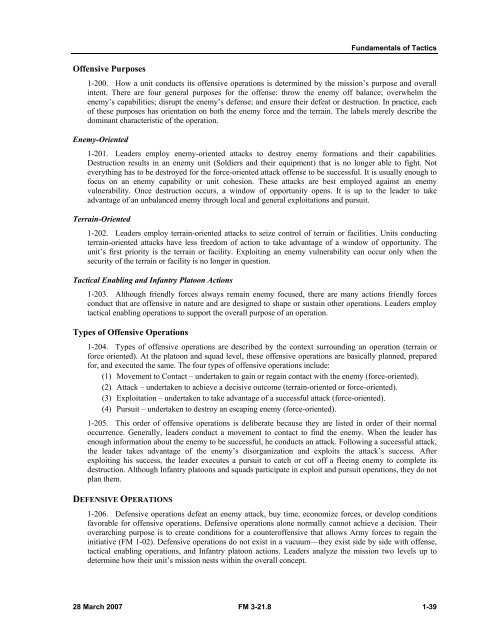Infantry Rifle Platoon and Squad - Sakai
Infantry Rifle Platoon and Squad - Sakai
Infantry Rifle Platoon and Squad - Sakai
Create successful ePaper yourself
Turn your PDF publications into a flip-book with our unique Google optimized e-Paper software.
Offensive Purposes<br />
Fundamentals of Tactics<br />
1-200. How a unit conducts its offensive operations is determined by the mission’s purpose <strong>and</strong> overall<br />
intent. There are four general purposes for the offense: throw the enemy off balance; overwhelm the<br />
enemy’s capabilities; disrupt the enemy’s defense; <strong>and</strong> ensure their defeat or destruction. In practice, each<br />
of these purposes has orientation on both the enemy force <strong>and</strong> the terrain. The labels merely describe the<br />
dominant characteristic of the operation.<br />
Enemy-Oriented<br />
1-201. Leaders employ enemy-oriented attacks to destroy enemy formations <strong>and</strong> their capabilities.<br />
Destruction results in an enemy unit (Soldiers <strong>and</strong> their equipment) that is no longer able to fight. Not<br />
everything has to be destroyed for the force-oriented attack offense to be successful. It is usually enough to<br />
focus on an enemy capability or unit cohesion. These attacks are best employed against an enemy<br />
vulnerability. Once destruction occurs, a window of opportunity opens. It is up to the leader to take<br />
advantage of an unbalanced enemy through local <strong>and</strong> general exploitations <strong>and</strong> pursuit.<br />
Terrain-Oriented<br />
1-202. Leaders employ terrain-oriented attacks to seize control of terrain or facilities. Units conducting<br />
terrain-oriented attacks have less freedom of action to take advantage of a window of opportunity. The<br />
unit’s first priority is the terrain or facility. Exploiting an enemy vulnerability can occur only when the<br />
security of the terrain or facility is no longer in question.<br />
Tactical Enabling <strong>and</strong> <strong>Infantry</strong> <strong>Platoon</strong> Actions<br />
1-203. Although friendly forces always remain enemy focused, there are many actions friendly forces<br />
conduct that are offensive in nature <strong>and</strong> are designed to shape or sustain other operations. Leaders employ<br />
tactical enabling operations to support the overall purpose of an operation.<br />
Types of Offensive Operations<br />
1-204. Types of offensive operations are described by the context surrounding an operation (terrain or<br />
force oriented). At the platoon <strong>and</strong> squad level, these offensive operations are basically planned, prepared<br />
for, <strong>and</strong> executed the same. The four types of offensive operations include:<br />
(1) Movement to Contact – undertaken to gain or regain contact with the enemy (force-oriented).<br />
(2) Attack – undertaken to achieve a decisive outcome (terrain-oriented or force-oriented).<br />
(3) Exploitation – undertaken to take advantage of a successful attack (force-oriented).<br />
(4) Pursuit – undertaken to destroy an escaping enemy (force-oriented).<br />
1-205. This order of offensive operations is deliberate because they are listed in order of their normal<br />
occurrence. Generally, leaders conduct a movement to contact to find the enemy. When the leader has<br />
enough information about the enemy to be successful, he conducts an attack. Following a successful attack,<br />
the leader takes advantage of the enemy’s disorganization <strong>and</strong> exploits the attack’s success. After<br />
exploiting his success, the leader executes a pursuit to catch or cut off a fleeing enemy to complete its<br />
destruction. Although <strong>Infantry</strong> platoons <strong>and</strong> squads participate in exploit <strong>and</strong> pursuit operations, they do not<br />
plan them.<br />
DEFENSIVE OPERATIONS<br />
1-206. Defensive operations defeat an enemy attack, buy time, economize forces, or develop conditions<br />
favorable for offensive operations. Defensive operations alone normally cannot achieve a decision. Their<br />
overarching purpose is to create conditions for a counteroffensive that allows Army forces to regain the<br />
initiative (FM 1-02). Defensive operations do not exist in a vacuum—they exist side by side with offense,<br />
tactical enabling operations, <strong>and</strong> <strong>Infantry</strong> platoon actions. Leaders analyze the mission two levels up to<br />
determine how their unit’s mission nests within the overall concept.<br />
28 March 2007 FM 3-21.8 1-39

















